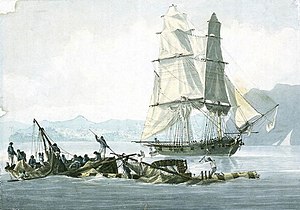HMS Speedy (1782)

HMS Speedy falling in with the wreck of HMS Queen Charlotte, 21 March 1800
|
|
| History | |
|---|---|
|
|
|
| Name: | HMS Speedy |
| Ordered: | 23 March 1781 |
| Builder: | Thomas King, Dover, Kent |
| Cost: | £4,200.7s.3d |
| Laid down: | June 1781 |
| Launched: | 29 June 1782 |
| Completed: | By 25 October 1782 |
| Captured: | By the French on 9 June 1794 |
|
|
|
| Name: | Speedy |
| Acquired: | 9 June 1794 |
| Captured: | 25 March 1795, by the Royal Navy |
|
|
|
| Name: | HMS Speedy |
| Acquired: | Retaken on 25 March 1795 |
| Captured: | By the French on 3 July 1801 |
|
|
|
| Name: | Saint Paul |
| Acquired: | 3 July 1801 |
| Out of service: | Donated to the Papal Navy in December 1802 |
|
|
|
| Name: | San Paolo |
| Acquired: | December 1802 |
| Fate: | Struck c.1806 |
| General characteristics | |
| Class and type: | 14-gun Speedy-class brig |
| Tons burthen: | 207 21⁄94 tons bm |
| Length: |
|
| Beam: | 25 ft 9 in (7.85 m) |
| Depth of hold: | 10 ft 10 in (3.30 m) |
| Propulsion: | Sails |
| Sail plan: | brig |
| Complement: | 90 |
| Armament: | 14 × 4-pounder guns + 12 × ½-pounder swivel guns |
HMS Speedy was a 14-gun Speedy-class brig of the British Royal Navy. Built during the last years of the American War of Independence, she served with distinction during the French Revolutionary Wars.
Built at Dover, Kent, Speedy spent most of the interwar years serving off the British coast. Transferred to the Mediterranean after the outbreak of the French Revolutionary Wars, she spent the rest of her career there under a number of notable commanders, winning fame for herself in various engagements and often against heavy odds. Her first commander in the Mediterranean, Charles Cunningham, served with distinction with several squadrons, assisting in the capture of several war prizes, such as the French frigates Modeste and Impérieuse. His successor, George Cockburn, impressed his superiors with his dogged devotion to duty. Speedy's next commander, George Eyre, had the misfortune to lose her to a superior French force on 9 June 1794.
She was soon retaken, and re-entered service under Hugh Downman, who captured a number of privateers between 1795 and 1799 and fought off an attack by the large French privateer Papillon on 3 February 1798. His successor, Jahleel Brenton, fought a number of actions against Spanish forces off Gibraltar. Her last captain, Lord Cochrane, forced the surrender of a much larger Spanish warship, the Gamo. Speedy was finally captured by a powerful French squadron in 1801 and donated to the Papal Navy by Napoleon the following year. She spent five years with them under the name San Paolo, but was struck around 1806.
...
Wikipedia
